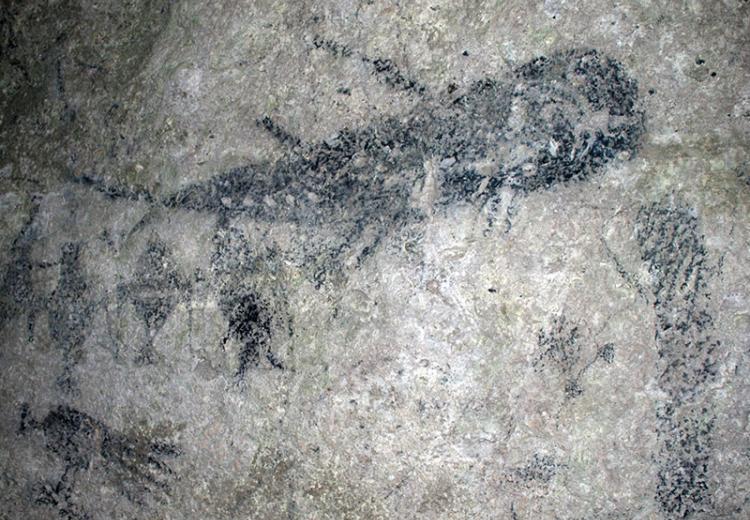Study Activity for Cave Art: Discovering Prehistoric Humans, Activity 3: How Did the Flintstones Really Live?

Cave drawings in Fels Cave, Lelepa Island.
(Note: Parts 1 through 4 of the LaunchPad are adapted from the educational games provided on the original Lascaux website from the French Ministry of Culture, accessible through the Internet Archive Wayback Machine.)
Introduction
We may never know exactly why early people produced the great images we have discovered deep in caves, but we do have a very good record of what they produced and also have a very good idea of how they produced them. Experts who study the past in by patiently reconstructing this long-ago world, know the importance of careful looking!
This Launchpad takes you on an adventure to the most famous cave of all, Lascaux, in southwestern France, and asks you to look around carefully, at what is inside it. Your teacher will help you gather some basic clues to the kinds of people who created the great art of the cave with the help of the activities, below.
Part 1: Where are the animals?
Go to the French Ministry of Culture’s website about Lascaux. Go to the top section on the pull-out menu on the left and find the history of the discovery of Lascaux in the fourth section of the pull-out menu, “Archaeological research.” If you need help reading, have your teacher or someone else help you read, or read to you aloud.
Now, explore the cave itself by clicking on each of the cave spaces listed below. Match the names of each of these pictures to the place where that picture is found: the Unicorn; the Back-to-Back Bison; the Chinese Horse; the human figure; the six red dots.
Part 2: What animals lived around here?
As you have just learned, Lascaux is very rich in many different types of animals as well as artistic ways of recording them. Look at the section of the website about Lascaux called “Parietal art” (Wall art)/ “Themes”, which you can find in the pull-out menu on the left side of the website. Write down or have someone help you write down the animals mentioned there. Then, look again at the list of special Lascaux areas in Part 1, and answer the following questions:
Which animal(s) or figure(s) is/are most commonly depicted at Lascaux?
Which almost never occur?
Why do you think this might be?
Now, look at the animals listed below. Search the Internet for pictures of the animals not familiar to you in the list below and compare the animals on that list with the animals you have already identified in Part 1 as being from Lascaux.
Which animals listed below are not part of your Lascaux list?
- Carnivores (meat eaters): bears, wolves, large wild cats
- Cattle, etc.: aurochs (an ancient type of wild cattle), bison, ibex
- Deer: does, stags, elk
- Horses: horses, donkeys, onagers (a type of wild donkey)
- Non-mammals: snakes, fish, birds
- Large Herbivores (plant eaters): mammoths, rhinoceros, primeval elephants
Why do you think these animals weren’t depicted there?
Part 3: What tools or objects did people use around here?
One of the ways we identify different prehistoric and ancient cultures or groups of people is by what types of tools or objects they used and how they used them. The prehistoric people who visited Lascaux have left evidence of their own tools and objects in and around the cave.
Find the section in the pull-out menu on the left of the website about Lascaux called “Parietal art /“Portable objects” and make a list or have someone help you make a list of all the tools and objects you see there.
Now answer the following questions:
The people of Lascaux certainly never used these objects or materials:
- Stone-Age Tools: polished axe, backed bladelet (small blade); burin (stone flake with a sharp edge for cutting)
- Bone Artifacts: awl, assegai (light wood spear with a stone/metal point),
- Jewelry (made from): copper, shell, bone
- Lighting: fireplace, lamp, torch
Part 4
After you have finished the three parts of the LaunchPad, above, you might want to compare what you have learned about Lascaux with the art that has been found in the well-known French caves of Cosquer Cave located at Cape Morgiou, near Marseilles on the Mediterranean Sea, and the cave of Chauvet-Pont-d'Arc in the Ardèche. To do this, go back to Parts 2 and 3 and substitute the name of the two caves here for that of Lascaux.
When you are finished, ask yourself: Did the people who used these three different caves record the same or different types of images? Did they leave the same or different tools or objects? What do these differences and/or similarities in that tell you about the people who made them?
